Gwalior, an historic city founded by King Surajesan, the formerly princely state of Madhya Pradesh, is famed for its outstanding palaces, sacred temples and glorious monuments. Gwalior's history is as fascinating as the attractions in the city, which can be traced back to the 8th century AD. It is believed that this city is named after the saint ‘Gwalipa’, who cured the king’s deadly disease. A cradle of great dynasties, this fabulous city was in existence over the centuries. Gwalior according to ancient history was Gopalkash, said to be the same place where Bhima from the epic Mahabharata attained victory. Archeological excavations reveal that the city dates back to the middle Stone ages and Iron Age. Gwalior is considered to be a city where a rich cultural tradition has been interwoven into the fabric of modern life.
How to reach here:
By Air: Gwalior airport is 8 km away from the heart of the city.
By Rail: Gwalior railway station is a major rail junction in Delhi-Chennai and Delhi-Mumbai rail line. It is connected to almost all cities like Delhi (Ndls Shatabdi E), Mumbai (Mngla Lksdp Exp), Kolkata (Chambal Express), Chennai (Chennai Rajdhni) and Bangalore (Karnataka Exp).
Best time to visit: October to March.
Languages spoken: Hindi, English.
Must eat: Kachodi, Samosa,pakodas,Jalebi ,rabri,Morena Gazak.
Famous Restaurants: Kwality, Swad, Blue Fox, Zayka.
Places you must visit:
Gwalior Fort is situated on an isolated rock, offering views of entire Gwalior town. Full of medieval architecture, the fort houses a number of historic buildings including Man Mandir, Gujari Mahal cum museum, Teli-ka-Mandir Temple and many others. It is one of the biggest forts in India and historical records state that it was built in the 8th century.Known as ‘The Pearl in the Necklace of the Forts of Hind’ by the Mughal Emperor Babur, the fort attracts thousands of tourists every year. The fort was constructed in two parts; the first part constitutes the main fort that was built during the early rule of the Tomaras. Apart from this, other buildings present in the fort were constructed by Raja Man Singh Tomar for his queen, Mrignayani during the 15th century.The groundwork for the Gwalior Fort was started by Raja Suraj Sen, around 1,000 years ago. Constructed on the advice of Sage Gwalipa, the fort witnessed the rule of various dynasties including Rajput kings, Kacchawa Pal Dynasty, Pratihara rulers, Muslim rulers, Tomaras, Lodi Dynasty, Mughals and the British.Spread across an area of about 3 sq km, the fort was constructed at a height of 100 metres above the city. Surrounded by walls of sandstone, the fort has three temples, six palaces and number of water tanks. The southern part of the fort attracts many tourists due to its rock faces with intricate carvings of the Jain tirthankars.

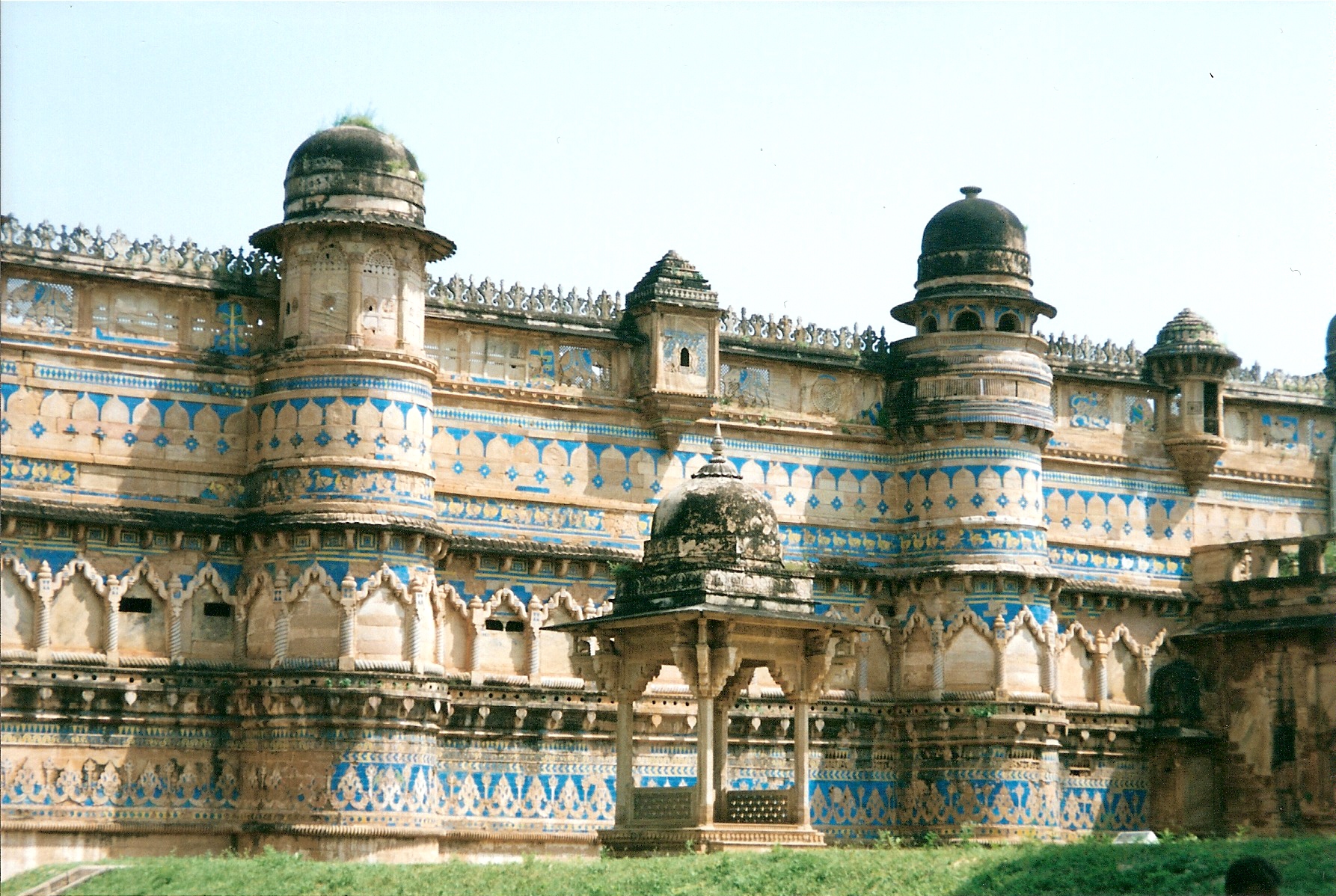

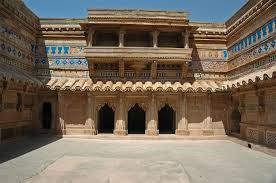
Phool Bagh is situated within the vicinity of Gwalior Railway Station. Constructed by late Madho Rao Scindia, Phool Bagh comprises a residential palace and a museum along with other buildings.The garden was inaugurated by the Prince of Wales in 1922 on his visit to Gwalior. Gwalior zoo along with a temple, a mosque and a Gurudwara are situated in the garden.



Suraj Kund is a tank located in the Gwalior Fort. The kund was constructed in the 15th century though its history dates back to as early as 425 AD. Legend states that during this period a king named Suraj Sen went into the forest for hunting and was missing.The king asked for water from the sage Gwalipa, who lived in the forest. The sage asked him to climb a hill for water. The water of the tank cured his leprosy and as a token of gratitude to the sage, he constructed the Suraj tank and a temple. The local people still believe that the water in the tank has medicinal power.


Hathi Pol is the main entrance of the Gwalior Fort. Also known as Hathiya Paur, the main gate offers direct entry to Man Mandir Palace, which was constructed by Man Singh.Possessing a series of seven gates, Hathi Pool is the last gate of the fort. The gate received its name from the statue of a life-sized elephant, which was once made at the entrance to the gate.The huge gate built with stone on the south-east corner of the palace has cylindrical towers that are covered with cupola domes. Another belief behind the name of this gate is its huge size through which even elephants could pass.The gate can only be accessed after passing through six other gates of the fort.
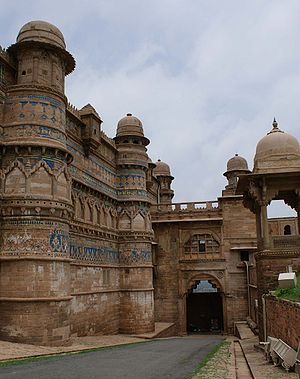
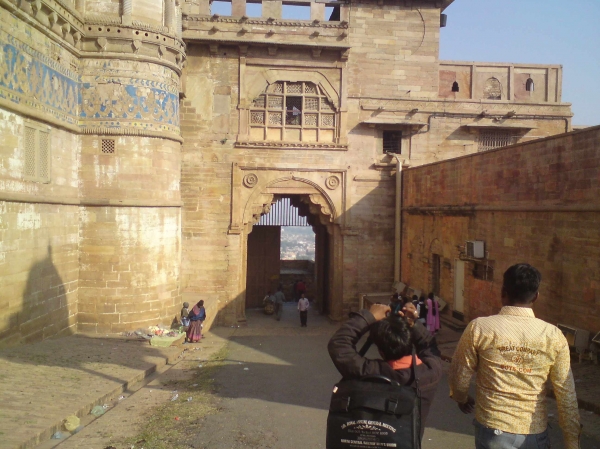
The Teli ka Mandir is a 9th century edifice, towering at 100 ft high. This is a Pratihara Vishnu temple of a unique blending of architectural styles. The shape of the roof is distinctively Dravidian, while the decorative embellishments have the typically Indo-Aryan characteristics of Northern India.

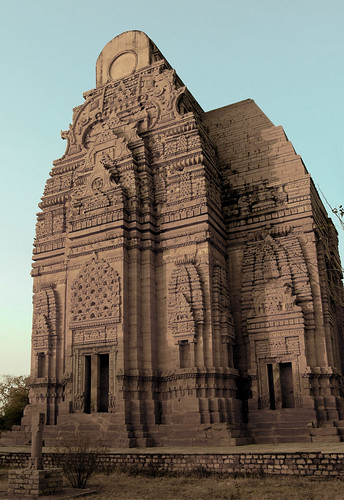
The Sas-Bahu Temple was constructed by the Gurjara-Pratihara Dynasty of Gwalior in the 11th century. The regional dynasty is called as the Kachchhapaghatas and is known for starting wielding power. The name of the temple is a short form for Shastra Bahu, another name of Lord Vishnu.The temple has idols of Lord Vishnu. Constructed by King Mahipala, the doorway offers tourists a wide view of idols of Lord Brahma, Lord Vishnu and Lord Shiva.The temple also comprises a stone carved three-storeyed building, which is designed without arches. Adding to the beauty of temple, the carved pillars along with a stairwell provide support to the huge structure.Raised on a platform, the walls of the temple have scriptures, figures and intricate stone works and is an example of the architectural skills of sculptors belonging to the 11th century.
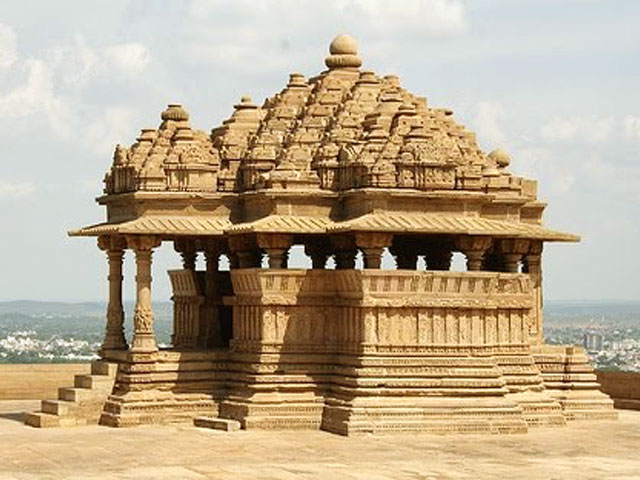

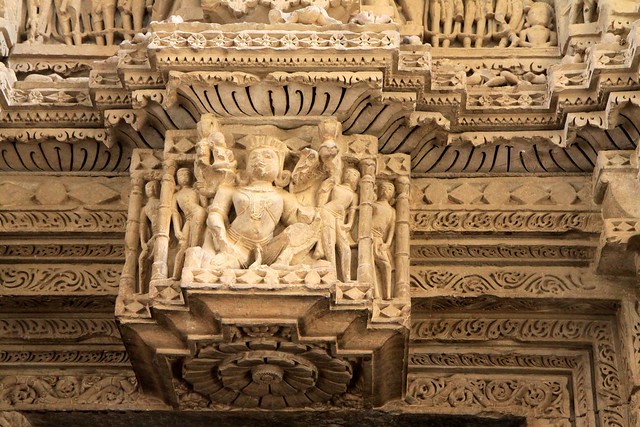



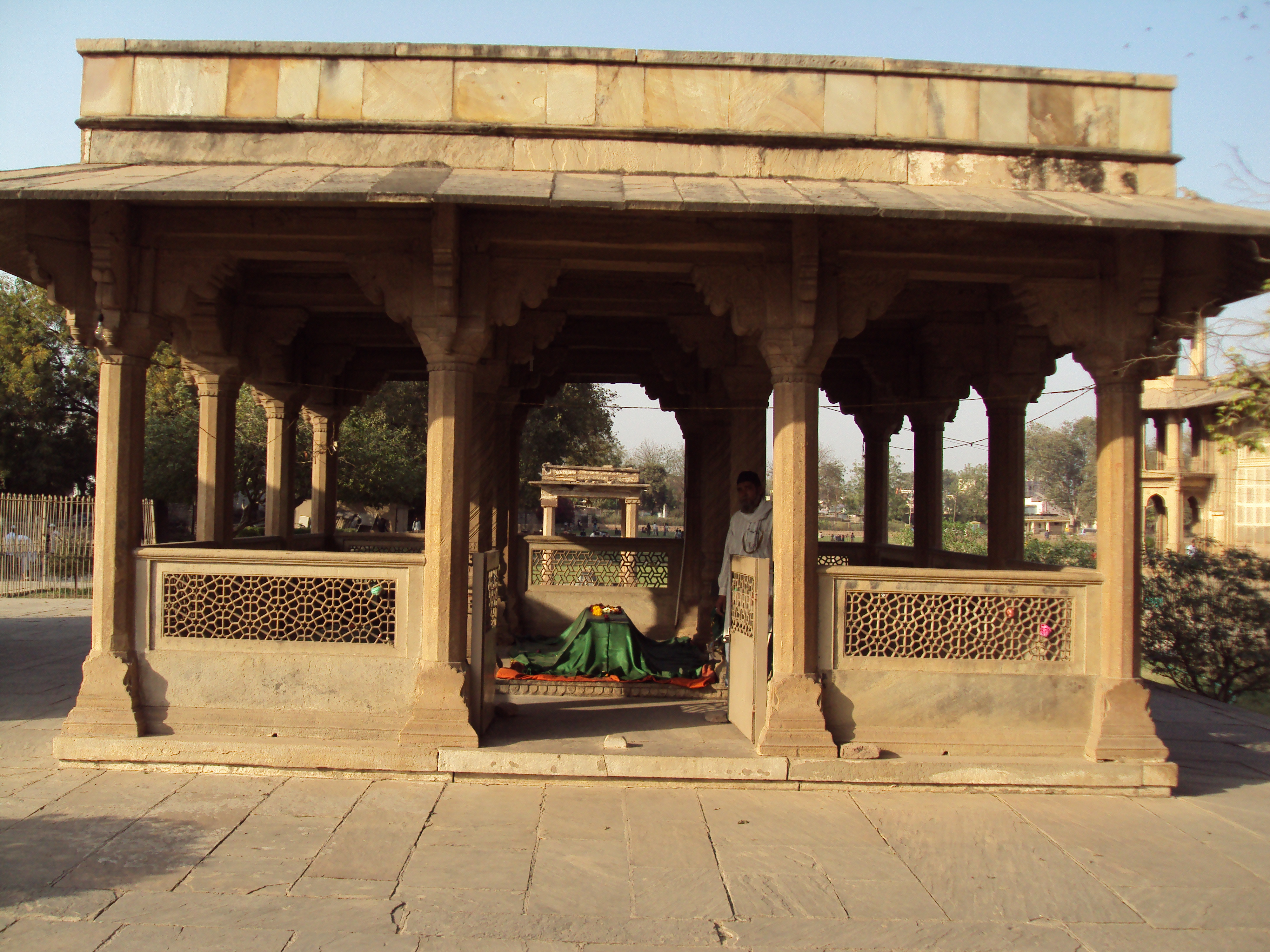
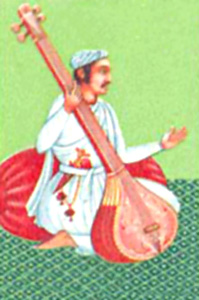
The tomb of Ghaus Mohammad is a prominent sightseeing attraction located in the old town of Hazira. Legend states that the tomb belongs to Ghous Mohammed, the Afghan prince, who later turned into a Sufi saint. According to history, the prince also helped Babur in acquiring the Gwalior Fort.Constructed in the 16th century, the tomb originally belonged to the time of Akbar. An example of Mughal architecture, the screens of the monument have been carved and developed using the pierced stone technique. The tomb has number of chhatris that are covered with blue tiles. Moreover, the walls feature intricate carvings and latticework.The Tomb of Ghous Mohammed is situated near the neighbouring tomb, which belongs to Tansen, a great composer and singer. Apart from being a prominent Sufi Shattari exponent and author, the Mohammed was also the spiritual mentor of Tansen.






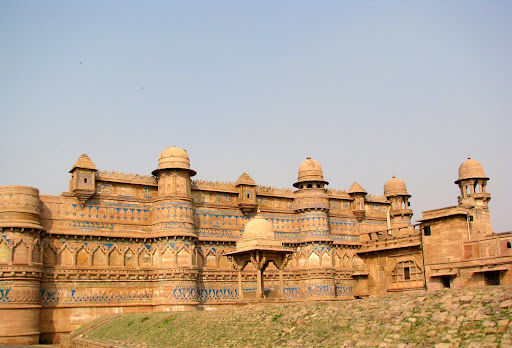

Jai Vilas Mahal is a huge and beautiful palace constructed in the European style. The 25 rooms of the palace have been converted into the museum. This standing Italianate structure is a combination of Tuscan and Corinthian architectural styles.Designed by Lt. Col. Sir Michael Filose, the palace was constructed by Maharaja Jivaji Rao Scindia in 1809. The beautiful palace houses furniture from Versailles, Italy and France. Two Belgian chandeliers weighing several tonnes are the prominent attraction of the palace.The palace also has historic swords, which were once worn by Aurangzeb and Shah Jahan during their ruling period. At present, some parts of the palace are occupied by the Scindia family.





Scindia Museum, also known as Jivaji Rao Scindia Museum, is a memorial dedicated to Jivaji Rao Scindia, one of the rulers of the Scindia reign. Jivaji Rao Scindia is a renowned ruler known for his progressive nature and contribution in constructing beautiful structures in and around Gwalior.Established in 1964, the museum is located inside Jai Vilas Palace and is controlled by a private trust. The museum is known for its wide collection of antiques and artifacts including weapons, miniature paintings, manuscripts, sculpture and coins.The museum also showcases cut glass and crystal ornaments, Malabar and Madurai woodwork and Persian carpets. A mechanical silver train which was used as drinks trolley can also be seen here. Chinese, Japanese and European art and curios and the gold painted Durbar Hall are other things to see.



The pristine Bateshwar valley is known for the ruins of beautiful temples within verdant woods. The panoramic lush surroundings add a charm to the ruined temples drawing both nature lovers and pilgrims to this site.



The fortress of Padavali is also known for the magnificent temple within the complex. The splendid architecture of the temple is worth seeing and the ten incarnations of Lord Vishnu can be seen here especially Ram Leela, Mahabharat, Krishna Leela, Samudra Manthan and the marriage ceremony of Lord Ganesha. The unique figurine to be viewed here is the idol of Lord Shiva who can be seen dancing as a Preta at a cemetery.



Gurudwara Data Bandi Chhod is a memorial constructed in the memory of Guru Hargobind Sahib, the 6th Sikh Guru. History states that Guru Hargobind Sahib was imprisoned in the premises by Jehangir for over two years. During the time of release of the guru, he also wanted 52 Hindu kings, who were his fellow prisoners, to be released.Built inside the Gwalior Fort, the Gurudwara was constructed in 1970. Made up of marble and colourful stained glass exteriors, the Gurudwara is one of the significant Sikh pilgrimage sites and is visited by many tourists each year. Jehangir gave instructions that whoever holds the robe of Guru would be freed. This incident earned the Guru the title of Data Bandi Chhod.Spread over six acres, the Gurudwara complex houses the Scindia School, Guru ka Langar with its huge dining hall and staff accommodation rooms in its adjoining compound.



The Chhatris of Scindia Dynasty are one of the prominent tourist attractions and is located in the Chhatri Bazar. Possessing various chhatris of the Scindia dynasty, these are famous for their architecture and beautiful structure.Apart from others, the Chhatris of Jivaji Rao Scindia, Daulat Rao Scindia and Janko ji Rao Scindia are well known. These chhatris preserve the beauty of the medieval period and are decorated with stone carvings of elephants, horses and tigers.
+of+the+Scindia+rulers,+Shivpuri,+Madhya+Pradesh2.jpg)
+of+the+Scindia+rulers,+Shivpuri,+Madhya+Pradesh23232.jpg)
+of+the+Scindia+rulers,+Shivpuri,+Madhya+Pradesh224.jpg)
+of+the+Scindia+rulers,+Shivpuri,+Madhya+Pradesh.jpg)
Dargah Khwaja Kanoon Sahib was built in the memory of Khwaja Kanoon Sahib Nagauri. He was a resident of Marwad and arrived in Gwalior during 1481. His full name was Saiyed Saiyeeduddin Kanoon Rehmat Ullah Aleh chishtiya, which is carved on the dome of the Dargah. Known as Khwaja Kanoon, Hazrat Khwaja Kanoon Sahib died in 940 Hijri, the Islamic Calendar. It is believed that visiting the Dargah for regularly 40 days fulfils all the desires.

Jauhar Kund is one of the prominent attractions, which is built within the Gwalior Fort. Besides palaces and temples, many tanks were built in the Gwalior Fort. The surroundings and the design of the tanks were made as per medieval architecture.For maintaining adequate water supply in the fort, the tanks were constructed near the water sources such as rivers, tributaries, water streams and lakes. Mansarovar Tal, Gangola Tal, KatoraTal, EkKhambha Tal, Rani Tal and Chedi Tal are the various tanks built within the fort.According to history, Jauhar Kund is the tank where Rajput women of the harem committed Jauhar or suicide, when the place was attacked by Iltumash. After the defeat of the King of Gwalior in 1232, the women of the region carried out mass sati or self-immolation around the tank.



The Samadhi of Rani Lakshmi Bai is located in the complex of Phool Bagh. Virangana Lakshmi Bai is a well known freedom fighter, who fought against the British for the freedom of the princely state, Jhansi.For paying tribute and respect to the Rani, an eight metaled tall statue of Rani Lakshmi Bai has been installed within the garden. In her honor and memory, every year a fair is organised in Gwalior on 18th June.

How to reach here:
By Air: Gwalior airport is 8 km away from the heart of the city.
By Rail: Gwalior railway station is a major rail junction in Delhi-Chennai and Delhi-Mumbai rail line. It is connected to almost all cities like Delhi (Ndls Shatabdi E), Mumbai (Mngla Lksdp Exp), Kolkata (Chambal Express), Chennai (Chennai Rajdhni) and Bangalore (Karnataka Exp).
Best time to visit: October to March.
Languages spoken: Hindi, English.
Must eat: Kachodi, Samosa,pakodas,Jalebi ,rabri,Morena Gazak.
Famous Restaurants: Kwality, Swad, Blue Fox, Zayka.
Places you must visit:
Gwalior Fort is situated on an isolated rock, offering views of entire Gwalior town. Full of medieval architecture, the fort houses a number of historic buildings including Man Mandir, Gujari Mahal cum museum, Teli-ka-Mandir Temple and many others. It is one of the biggest forts in India and historical records state that it was built in the 8th century.Known as ‘The Pearl in the Necklace of the Forts of Hind’ by the Mughal Emperor Babur, the fort attracts thousands of tourists every year. The fort was constructed in two parts; the first part constitutes the main fort that was built during the early rule of the Tomaras. Apart from this, other buildings present in the fort were constructed by Raja Man Singh Tomar for his queen, Mrignayani during the 15th century.The groundwork for the Gwalior Fort was started by Raja Suraj Sen, around 1,000 years ago. Constructed on the advice of Sage Gwalipa, the fort witnessed the rule of various dynasties including Rajput kings, Kacchawa Pal Dynasty, Pratihara rulers, Muslim rulers, Tomaras, Lodi Dynasty, Mughals and the British.Spread across an area of about 3 sq km, the fort was constructed at a height of 100 metres above the city. Surrounded by walls of sandstone, the fort has three temples, six palaces and number of water tanks. The southern part of the fort attracts many tourists due to its rock faces with intricate carvings of the Jain tirthankars.



Phool Bagh is situated within the vicinity of Gwalior Railway Station. Constructed by late Madho Rao Scindia, Phool Bagh comprises a residential palace and a museum along with other buildings.The garden was inaugurated by the Prince of Wales in 1922 on his visit to Gwalior. Gwalior zoo along with a temple, a mosque and a Gurudwara are situated in the garden.



Suraj Kund is a tank located in the Gwalior Fort. The kund was constructed in the 15th century though its history dates back to as early as 425 AD. Legend states that during this period a king named Suraj Sen went into the forest for hunting and was missing.The king asked for water from the sage Gwalipa, who lived in the forest. The sage asked him to climb a hill for water. The water of the tank cured his leprosy and as a token of gratitude to the sage, he constructed the Suraj tank and a temple. The local people still believe that the water in the tank has medicinal power.


Hathi Pol is the main entrance of the Gwalior Fort. Also known as Hathiya Paur, the main gate offers direct entry to Man Mandir Palace, which was constructed by Man Singh.Possessing a series of seven gates, Hathi Pool is the last gate of the fort. The gate received its name from the statue of a life-sized elephant, which was once made at the entrance to the gate.The huge gate built with stone on the south-east corner of the palace has cylindrical towers that are covered with cupola domes. Another belief behind the name of this gate is its huge size through which even elephants could pass.The gate can only be accessed after passing through six other gates of the fort.


The Teli ka Mandir is a 9th century edifice, towering at 100 ft high. This is a Pratihara Vishnu temple of a unique blending of architectural styles. The shape of the roof is distinctively Dravidian, while the decorative embellishments have the typically Indo-Aryan characteristics of Northern India.


The Sas-Bahu Temple was constructed by the Gurjara-Pratihara Dynasty of Gwalior in the 11th century. The regional dynasty is called as the Kachchhapaghatas and is known for starting wielding power. The name of the temple is a short form for Shastra Bahu, another name of Lord Vishnu.The temple has idols of Lord Vishnu. Constructed by King Mahipala, the doorway offers tourists a wide view of idols of Lord Brahma, Lord Vishnu and Lord Shiva.The temple also comprises a stone carved three-storeyed building, which is designed without arches. Adding to the beauty of temple, the carved pillars along with a stairwell provide support to the huge structure.Raised on a platform, the walls of the temple have scriptures, figures and intricate stone works and is an example of the architectural skills of sculptors belonging to the 11th century.




The Memorial of Tansen, also known as the ‘Tomb of Tansen’, is located in the vicinity of the tomb of Muhammad Ghaus. Surrounded by gardens, the tomb is has a typical Mughal architectural style. The construction of the tomb is simple compared to other architectural wonders of the country.Buried in the tomb complex of Muhammad Ghaus, Tansen was a follower of the Sufi saint. He also learnt Hindustani classical music and several ragas from Muhammad Ghaus, his music teacher. Tansen was an exponent of the Dhrupad style and developed the Gwalior Gharana style.Apart from being a beautiful monument, the tomb also serves as a part of the living cultural heritage of Gwalior. A national level music festival is organised every year during the months of November and December at the tomb. Many emerging musicians and singers perform at the site during festivals and competitions.




The tomb of Ghaus Mohammad is a prominent sightseeing attraction located in the old town of Hazira. Legend states that the tomb belongs to Ghous Mohammed, the Afghan prince, who later turned into a Sufi saint. According to history, the prince also helped Babur in acquiring the Gwalior Fort.Constructed in the 16th century, the tomb originally belonged to the time of Akbar. An example of Mughal architecture, the screens of the monument have been carved and developed using the pierced stone technique. The tomb has number of chhatris that are covered with blue tiles. Moreover, the walls feature intricate carvings and latticework.The Tomb of Ghous Mohammed is situated near the neighbouring tomb, which belongs to Tansen, a great composer and singer. Apart from being a prominent Sufi Shattari exponent and author, the Mohammed was also the spiritual mentor of Tansen.


Gujari Mahal is one of the palaces in Gwalior which has now been transformed into a museum. The palace was constructed during the 15th century by Raja Man Singh for his wife Mrignayani, a Gujar princess.It was built on demand of the queen that she needed a separate palace for herself with regular water supply. For fulfilling the same, the structure was constructed near the Rai River.The palace was converted into a museum in 1922 and is known by the name of Central Archaeological Museum. Housing 28 galleries and around 6,000 artefacts, the museum is known for its collection of sculptures, coins, pottery, terracotta, paintings, inscriptions and weapons. The museum possesses antiques from the 2nd century to at least 300 years ago.The rich collection of sculptures displayed in the museum includes the famous Shalabhanjika Yakshi, Nataraj Ardhanareshwar, Trimurthi and Yamraj. Apart from this, a terracotta collection ranging from the 2nd to 5th century images of Ram, Sita and others can also be seen in the museum.The collection provides evidences that fifteen among the thirty one great singers of the country, including Tansen, learnt classical singing in this mahal. The museum is also popular for a huge collection of photographs including the Bagh Cave paintings and monuments of India.A 75-year-old photograph of the Mandu and Dhar areas is the main attraction for history lovers. The fort also has a miniature statue of Salabhanjika, which can be seen by special permission.



Man Mandir Palace was constructed by Man Singh Tomar between the years 1486-1517. The palace was ruled by various rulers such as Kachwaha Rajputs, Qutubiddin Aibawk, the Tomaras, Mughals, Marathas, the British and the Scindias.Influenced by both Hindu and medieval architecture, the exteriors of the palace are decorated with designed tiles. The chambers are decorated with carved stone walls. The interiors of the palace are designed with coloured paintings of human figures, animals and flowers and glazed tiles.This palace is also known as Chit Mandir or Painted Palace. It is constructed in four levels, out of which two are underground. The palace is an 80 feet high structure, which has six rounded towers with cupolas.The circular prison within the palace witnessed imprisonment and murder of Murad, who was killed by his brother Aurangzeb, the Mughal emperor. Jhulagar, Kesar Kunda and Phansi Ghar are the prominent structural premises, which were used during the Mughal era.


Jai Vilas Mahal is a huge and beautiful palace constructed in the European style. The 25 rooms of the palace have been converted into the museum. This standing Italianate structure is a combination of Tuscan and Corinthian architectural styles.Designed by Lt. Col. Sir Michael Filose, the palace was constructed by Maharaja Jivaji Rao Scindia in 1809. The beautiful palace houses furniture from Versailles, Italy and France. Two Belgian chandeliers weighing several tonnes are the prominent attraction of the palace.The palace also has historic swords, which were once worn by Aurangzeb and Shah Jahan during their ruling period. At present, some parts of the palace are occupied by the Scindia family.





Scindia Museum, also known as Jivaji Rao Scindia Museum, is a memorial dedicated to Jivaji Rao Scindia, one of the rulers of the Scindia reign. Jivaji Rao Scindia is a renowned ruler known for his progressive nature and contribution in constructing beautiful structures in and around Gwalior.Established in 1964, the museum is located inside Jai Vilas Palace and is controlled by a private trust. The museum is known for its wide collection of antiques and artifacts including weapons, miniature paintings, manuscripts, sculpture and coins.The museum also showcases cut glass and crystal ornaments, Malabar and Madurai woodwork and Persian carpets. A mechanical silver train which was used as drinks trolley can also be seen here. Chinese, Japanese and European art and curios and the gold painted Durbar Hall are other things to see.


The pristine Bateshwar valley is known for the ruins of beautiful temples within verdant woods. The panoramic lush surroundings add a charm to the ruined temples drawing both nature lovers and pilgrims to this site.



The fortress of Padavali is also known for the magnificent temple within the complex. The splendid architecture of the temple is worth seeing and the ten incarnations of Lord Vishnu can be seen here especially Ram Leela, Mahabharat, Krishna Leela, Samudra Manthan and the marriage ceremony of Lord Ganesha. The unique figurine to be viewed here is the idol of Lord Shiva who can be seen dancing as a Preta at a cemetery.

Gurudwara Data Bandi Chhod is a memorial constructed in the memory of Guru Hargobind Sahib, the 6th Sikh Guru. History states that Guru Hargobind Sahib was imprisoned in the premises by Jehangir for over two years. During the time of release of the guru, he also wanted 52 Hindu kings, who were his fellow prisoners, to be released.Built inside the Gwalior Fort, the Gurudwara was constructed in 1970. Made up of marble and colourful stained glass exteriors, the Gurudwara is one of the significant Sikh pilgrimage sites and is visited by many tourists each year. Jehangir gave instructions that whoever holds the robe of Guru would be freed. This incident earned the Guru the title of Data Bandi Chhod.Spread over six acres, the Gurudwara complex houses the Scindia School, Guru ka Langar with its huge dining hall and staff accommodation rooms in its adjoining compound.



The Chhatris of Scindia Dynasty are one of the prominent tourist attractions and is located in the Chhatri Bazar. Possessing various chhatris of the Scindia dynasty, these are famous for their architecture and beautiful structure.Apart from others, the Chhatris of Jivaji Rao Scindia, Daulat Rao Scindia and Janko ji Rao Scindia are well known. These chhatris preserve the beauty of the medieval period and are decorated with stone carvings of elephants, horses and tigers.
+of+the+Scindia+rulers,+Shivpuri,+Madhya+Pradesh2.jpg)
+of+the+Scindia+rulers,+Shivpuri,+Madhya+Pradesh23232.jpg)
+of+the+Scindia+rulers,+Shivpuri,+Madhya+Pradesh224.jpg)
+of+the+Scindia+rulers,+Shivpuri,+Madhya+Pradesh.jpg)
Dargah Khwaja Kanoon Sahib was built in the memory of Khwaja Kanoon Sahib Nagauri. He was a resident of Marwad and arrived in Gwalior during 1481. His full name was Saiyed Saiyeeduddin Kanoon Rehmat Ullah Aleh chishtiya, which is carved on the dome of the Dargah. Known as Khwaja Kanoon, Hazrat Khwaja Kanoon Sahib died in 940 Hijri, the Islamic Calendar. It is believed that visiting the Dargah for regularly 40 days fulfils all the desires.

Jauhar Kund is one of the prominent attractions, which is built within the Gwalior Fort. Besides palaces and temples, many tanks were built in the Gwalior Fort. The surroundings and the design of the tanks were made as per medieval architecture.For maintaining adequate water supply in the fort, the tanks were constructed near the water sources such as rivers, tributaries, water streams and lakes. Mansarovar Tal, Gangola Tal, KatoraTal, EkKhambha Tal, Rani Tal and Chedi Tal are the various tanks built within the fort.According to history, Jauhar Kund is the tank where Rajput women of the harem committed Jauhar or suicide, when the place was attacked by Iltumash. After the defeat of the King of Gwalior in 1232, the women of the region carried out mass sati or self-immolation around the tank.



The Samadhi of Rani Lakshmi Bai is located in the complex of Phool Bagh. Virangana Lakshmi Bai is a well known freedom fighter, who fought against the British for the freedom of the princely state, Jhansi.For paying tribute and respect to the Rani, an eight metaled tall statue of Rani Lakshmi Bai has been installed within the garden. In her honor and memory, every year a fair is organised in Gwalior on 18th June.
AWESOME BLOG, THANKS A LOT 4 SUCH A WONDERFUL INFORMATION, COLLECTION and KNOWLEDGE
ReplyDeleteThanks a lot. Such appreciative words inspires me...
Deletevery nice. thanks
ReplyDeleteVery nice info. Thanks
ReplyDeleteVery nice info. Thanks
ReplyDeleteNice blog ....Thanks for sharing this article with us. Book cab from our various options and let us make your holiday a moment to always remember. https://www.bharattaxi.com/gwalior
ReplyDeleteFind Best Domestic Travel Agent provider in Gwalior at best price Contact with us Chaturvedi cab Services
ReplyDeleteLooking for interior Designer in Gwalior? Then Bohre Interior Designer is the best place for you.
ReplyDelete